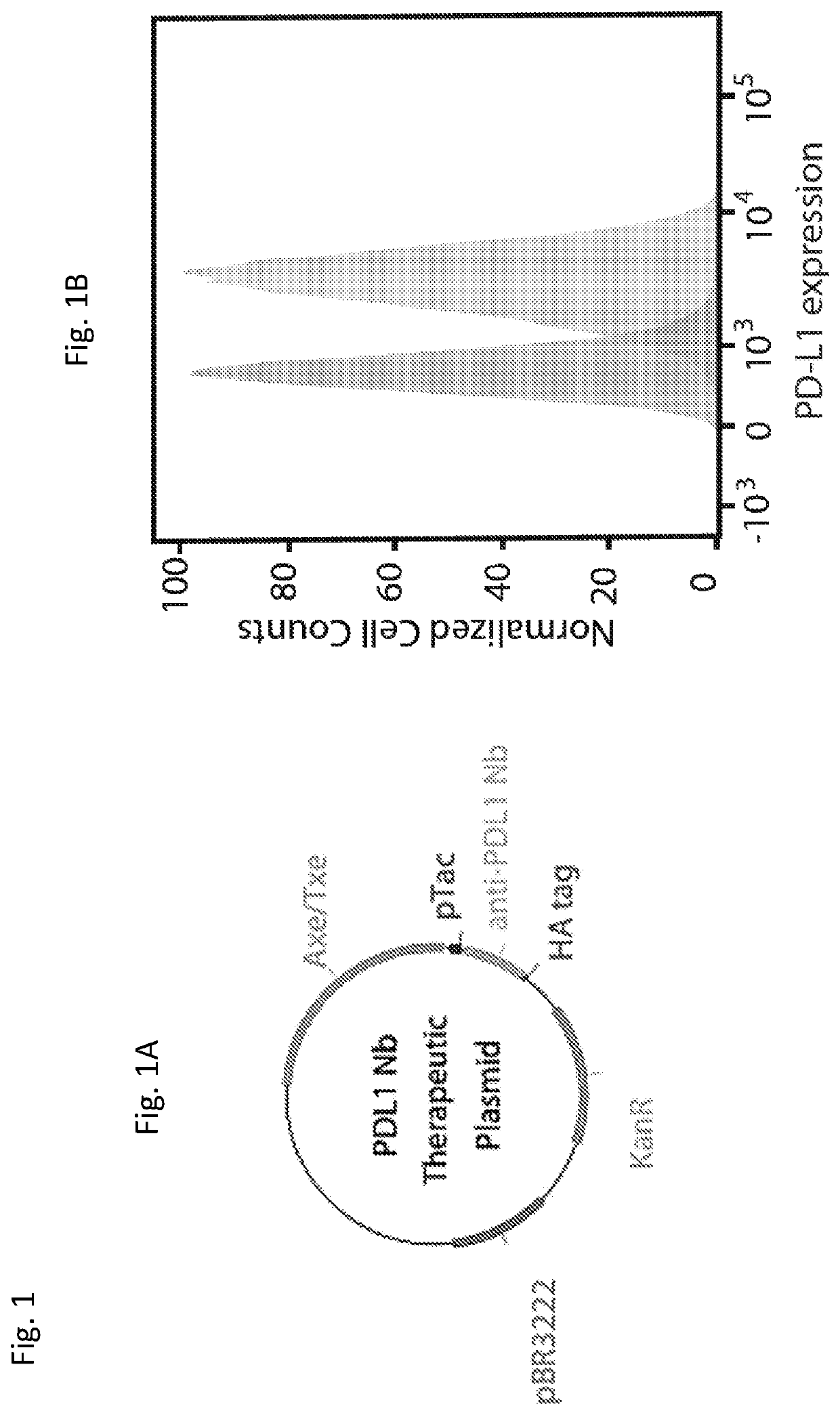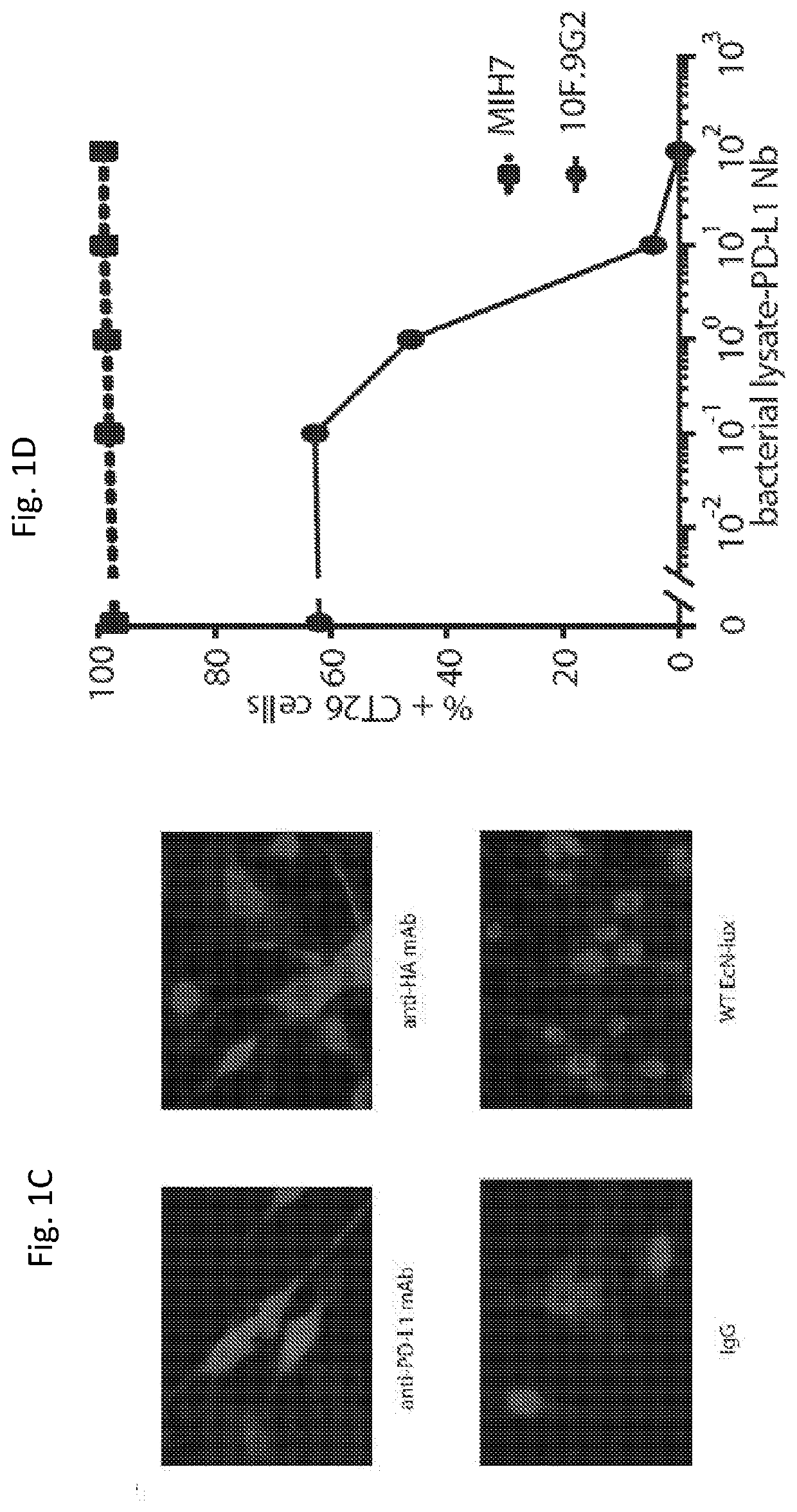Programmable bacteria for the treatment of cancer
- Summary
- Abstract
- Description
- Claims
- Application Information
AI Technical Summary
Benefits of technology
Problems solved by technology
Method used
Image
Examples
example 1
Containing PD-L1 and CTLA4 Nanobody as the Deliverable Therapeutic
Agent—Materials and Methods for Examples 2-6
Plasmid and Strains
[0223]The circuit strains were cultured in LB media with their respective antibiotics (sc101*variant: 100 μg ml−1ampicillin, p15A variant: 100 μg ml−′ spectinomycin, colE1: 100 μg ml-1 spectinomycin, and all with 50 μg ml−1 spectinomycin and kanamycin for strains also transformed with PD-L1 therapeutic plasmid) with 0.2% glucose, in a 37° C. shaking incubator. CT26 and 4T1 mammalian cells were purchased from ATCC and cultured in RPMI supplemented with 10% fetal bovine serum and 1% penicillin / streptomycin. A20 cells were purchased from ATCC and cultured in RPMI supplemented with 10% fetal bovine serum and 1% penicillin / streptomycin and 0.01% 2-Mercaptoethanol. Mammalian cells were grown inside a 37° C. tissue culture incubator maintained at 5% CO2. Plasmids were constructed using Gibson assembly cloning methods and integrated into the φ80 site of E. coli Ni...
example 2
ion and Characterization of a Probiotically-Expressed PD-L1 Nanobody
[0243]A single-domain antibody, or nanobody (Nb), blocking PD-L1 was chosen from the RCSB Protein Data Bank as therapeutic cargo. Unlike antibodies with a molecular size of approximately 160 kDa, Nbs are only 15 kDa and lack an Fc region (which requires glycosylation by mammalian cells), and therefore Nbs can be produced recombinantly in bacteria (Bannas et al. 2017; Lee and Jeong 2015). Nbs provide multiple advantages, including their small size, which allows for increased diffusion within the tumor microenvironment and more rapid clearance from the bloodstream through glomerular filtration thereby reducing systemic toxicity (Hu et al. 2017). While faster blood clearance may suggest shorter therapeutic impact, the bacterial platform allows for continuous and intratumoral Nb production to improve upon this limitation.
[0244]The PD-L1 Nb sequence (SEQ ID NO: 1) as cloned downstream of a strong constitutive pTac promot...
example 3
ion of the Synchronized Lysis Circuit as a Controllable Release Mechanism
[0247]Since a dose-dependent binding of the Nb to PD-L1 was observed, optimization of the therapeutic release was sought by building upon a recent synchronized lysis circuit (SLC), whereby a bacterial population lyses once a critical density is reached (Din et al. 2016). The SLC has been shown to aid in tumor-selective production, population limitation, and therapeutic release, serving multiple purposes critical for translational efforts. To make this circuit more stable, the original SLC two-plasmid system was combined into a single operon, one-plasmid system that then was genomically integrated into EcN-lux. In this optimized system, the quorum sensing plux promoter drives transcription of both quorum sensing genes, luxR and luxI, and the phage-derived lysis gene, φX174E (FIG. 2A). Use of only one promoter and one terminator allowed for this smaller module to be easily integrated and reduce repeated sequences...
PUM
| Property | Measurement | Unit |
|---|---|---|
| Time | aaaaa | aaaaa |
| Mass | aaaaa | aaaaa |
| Electric charge | aaaaa | aaaaa |
Abstract
Description
Claims
Application Information
 Login to view more
Login to view more - R&D Engineer
- R&D Manager
- IP Professional
- Industry Leading Data Capabilities
- Powerful AI technology
- Patent DNA Extraction
Browse by: Latest US Patents, China's latest patents, Technical Efficacy Thesaurus, Application Domain, Technology Topic.
© 2024 PatSnap. All rights reserved.Legal|Privacy policy|Modern Slavery Act Transparency Statement|Sitemap



